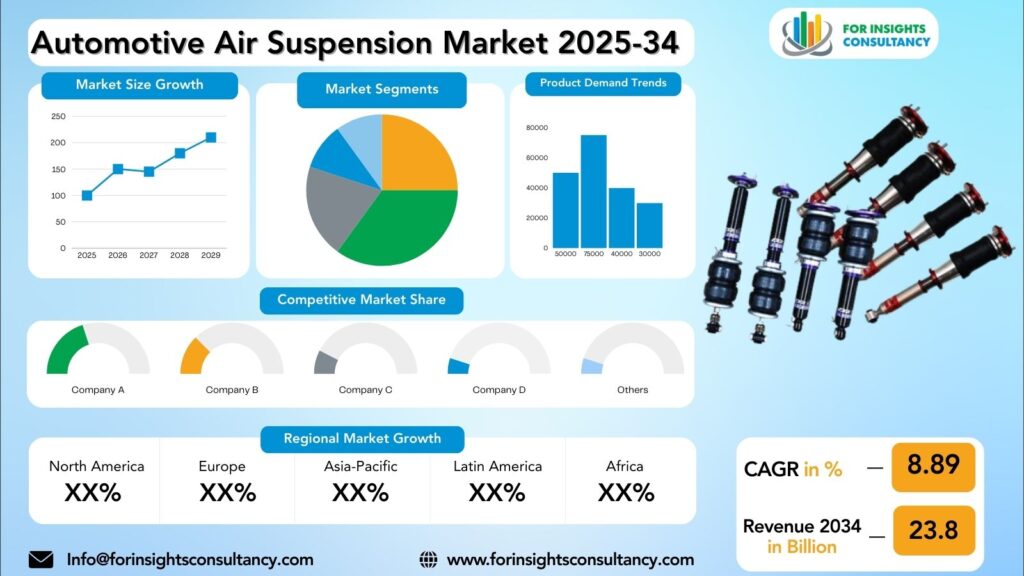
Automotive Air Suspension Market Research Report by Component (Air Springs/Airbags, Compressors and Reservoirs, Electronic Control Units (ECUs), Height & Pressure Sensors)), By Technology/Control Type (Electronically Controlled Air Suspension (ECAS), Non-Electronically Controlled Air Suspension (NECAS), Passive Air Suspension, Semi-Active / Adaptive Air Suspension, Fully Active Air Suspension), by Vehicle Type, by Sales Channel, and by Region Global Market Analysis and Forecast, 2025-2034
Sep-2025 Formats | PDF | Category: Automotive | Delivery: 24 to 72 Hours
Automotive Air Suspension Market is forecast to increase from USD 11.74 Billion in 2025 to USD 23.8 Billion by 2034, at a CAGR of 8.89%.
Automotive Air Suspension Market: A Comprehensive Overview and Future Developments
Automotive air suspension systems are gaining popularity due to their ability to provide a smoother ride, improved handling, and customizable ride height. The market is projected to see significant growth due to advancements in technology and increasing consumer demand for comfort and performance. Air springs, filled with pressurized air, can be adjusted to change the vehicle’s ride height and stiffness, resulting in a more comfortable ride and improved handling.
Future developments include the integration of advanced sensors and electronic control systems for real-time adjustment of ride height and stiffness, the development of smart air suspension systems that automatically adapt to road conditions and driving styles, and the expansion of air suspension technology into mainstream and entry-level vehicle segments.
Automotive Air Suspension Market Dynamics
Growth Drivers
The automotive air suspension market is experiencing growth due to the increasing demand for superior comfort and luxury features, such as smooth and comfortable rides, and the continuous technological advancements in air suspension systems. These systems provide better shock absorption and stability, enhancing the overall driving experience. The global shift towards electric vehicles (EVs) is also driving the demand for air suspension systems, as manufacturers incorporate them to improve ride comfort, handling, and energy efficiency.
Vehicle safety and performance are top priorities for both consumers and automakers, and air suspension systems play a crucial role in enhancing these by providing better stability, control, and handling. As a result, many manufacturers are opting for air suspension systems to improve their vehicles’ safety and performance.
The rise of autonomous vehicles is also contributing to the growth of the automotive air suspension market. Air suspension systems are essential for ensuring a smooth and comfortable ride in autonomous vehicles, as they can adjust to changing road conditions and driving styles. This has led to an increased demand for air suspension systems in the autonomous vehicle segment, further propelling the market’s growth.
Restraints
The automotive air suspension market faces several challenges, including high implementation costs, limited availability in entry-level vehicles, higher maintenance and repair costs, and limited aftermarket support. Air suspension systems are more complex and require advanced technology, leading to higher production costs and higher consumer costs. This can result in consumers opting for traditional suspension systems to save on costs, affecting the overall demand for air suspension. Entry-level vehicles are often not equipped with air suspension, limiting the market penetration of this technology. Maintenance and repair costs are also higher due to the complexity of air suspension systems, requiring specialized skills and tools. Additionally, finding replacement parts or specialized technicians for air suspension systems can be difficult, leading to longer downtimes and higher repair costs. These factors contribute to the overall adoption of air suspension systems in the automotive market.
Opportunities
Manufacturers are integrating advanced technologies like electronic control systems, adaptive dampers, and predictive analytics into air suspension systems to improve ride quality and performance. This technology is expanding to commercial vehicles like trucks, buses, and trailers, enhancing safety, cargo protection, and fuel efficiency. The aftermarket segment offers significant opportunities for companies offering air suspension kits and components, as enthusiasts and custom car builders invest in these solutions to upgrade their vehicles and achieve unique looks.
Challenges
The automotive air suspension market faces several challenges, including high initial investment, complexity, reliability, and market competition. The high initial investment can deter potential customers who prefer more affordable options. The complexity of air suspension systems requires specialized equipment and expertise, which may deter consumers who prefer simpler solutions. Reliability is another key issue, as air suspension systems can be prone to leaks and other issues that affect their reliability over time. The increasing demand for advanced suspension systems makes it difficult for companies to stand out and differentiate their products. Innovation and strategic marketing efforts are essential for maintaining a competitive edge in this evolving market.
Automotive Air Suspension Market Top Companies Covered In This Report:
Evaluate The Strategic Positioning And Innovation Pipelines Of Leading Market Companies-From Multinational Enterprises To Disruptive Regional Firms. Understand How Key Players Are Innovating, Expanding, And Capturing Value, And Use Competitive Benchmarks To Plan Your Next Move.
- Continental AG (Germany)
- ThyssenKrupp AG (Germany)
- SAF Holland (Germany)
- Hendrickson International (U.S.)
- Firestone Industrial Products Company, LLC (U.S.)
- Vibracoustic SE (Germany)
- HL Mando Corporation (South Korea)
- Hitachi Astemo Ltd. (Japan)
- AccuAir Control Systems, L.L.C. (U.S.)
- ZF Friedrichshafen AG (Germany)
Automotive Air Suspension Market News
ZF Friedrichshafen
ZF continued to promote its sMOTION active suspension system, which is capable of real-time damping adjustments based on road preview data. The system, deployed in high-end vehicles like the Porsche Panamera and Taycan, represents a key innovation in fully active air suspension.
In its H1 2025 financial report, ZF announced an acceleration of its restructuring program to address a challenging market, while building up its profitable Chassis Solutions division. This indicates a clear strategic focus on its core suspension and steering business.
ThyssenKrupp Bilstein
Bilstein continued to roll out new products in 2024 and 2025, including the Bilstein B16 DT performance kits, which offer a plug-and-play upgrade for vehicles with factory electronic suspension. The company also emphasized its Bilstein B4 air suspension modules, which serve as OE-quality replacement parts for both active and passive air suspension systems.
BWI Group
In February 2025, BWI announced a project with a leading Chinese automaker to supply its magnetic fluid suspension for multiple models, with an annual volume of 400,000 units. The company emphasized that this fourth-generation system, which adjusts damping up to 1,000 times per second, will be mass-produced in China in mid-2025.
Hendrickson
In early 2024, Hendrickson launched the ROADMAAX Z rear air suspension system, designed for demanding applications that require both on- and off-highway performance. In late 2024, the company announced that its PRIMAAX® EX rear air suspension system was being offered on International® Trucks, expanding its product line with a major OEM.
Segmented View of the Industry:
The Automotive Air Suspension Market Is Mapped Through A Multidimensional Lens-Tracking Shifts Across Product Type, Applications, And Geographic Regions. This Segmented Approach Enables Businesses To Localize Their Growth Plans And Align Offerings With The Most Profitable Demand Centers.
Segmentation by Component
- Air Springs/Airbags
- Compressors and Reservoirs
- Electronic Control Units (ECUs)
- Height & Pressure Sensors
Segmentation by Technology/Control Type
- Electronically Controlled Air Suspension (ECAS)
- Non-Electronically Controlled Air Suspension (NECAS)
- Passive Air Suspension
- Semi-Active / Adaptive Air Suspension
- Fully Active Air Suspension
Segmentation by Vehicle Type
- Passenger Cars
- Light Commercial Vehicles
- Medium and Heavy Trucks & Buses
Segmentation by Sales Channel/End-User
- Original Equipment Manufacturer (OEM)
- Aftermarket
Global Geographic Coverage:
The Report Provides In-Depth Qualitative and Quantitative Data On the Automotive Air Suspension Market For All Of The Regions And Countries Listed Below:
North America
The Automotive Air Suspension Market in North America is undergoing rapid growth due to technological advancements and increasing demand for high-performance vehicles. The US market is characterized by the increasing adoption of luxury vehicles and a focus on customization, with key market players and a robust aftermarket sector. The demand for enhanced comfort and superior ride quality is driving the popularity of air suspension systems in the US. Canada, on the other hand, is gaining prominence due to the rising trend of premium vehicle ownership and a preference for off-road capabilities.
The market is also shifting towards eco-friendly solutions and sustainable mobility, with consumers seeking smoother rides and improved handling. In Mexico, the market is experiencing a surge in demand due to increased investments in the automotive sector and a growing preference for high-performance vehicles. The adoption of air suspension systems is expected to increase across the country. Overall, the Automotive Air Suspension Market in North America is set to play a key role in shaping the future of the automotive industry.
Europe
Germany, renowned for its precision engineering and automotive prowess, has become a key player in the automotive air suspension market. Leading car manufacturers like BMW, Mercedes-Benz, and Audi have integrated air suspension systems into their vehicles, resulting in significant growth. The country’s focus on innovation and technological advancements has fueled the adoption of air suspension systems in both luxury and mainstream vehicles. The presence of multiple aftermarket suppliers and service providers has also contributed to the market’s expansion.
France has also experienced steady growth in the automotive air suspension market, driven by the increasing demand for comfort and performance. French car manufacturers like Peugeot and Renault have started incorporating air suspension systems to enhance the driving experience. The country’s focus on sustainability and environmental consciousness has also influenced the adoption of air suspension systems, as they improve fuel efficiency and reduce emissions.
The United Kingdom has also seen a surge in the adoption of automotive air suspension systems due to the increasing demand for luxury and high-performance vehicles. Leading car manufacturers like Jaguar Land Rover and Bentley have integrated air suspension technology into their models, providing a smoother and more refined driving experience. The country’s strong aftermarket industry and growing network of service providers further support the market’s growth, offering consumers a wide range of options for vehicle upgrades.
Asia Pacific
China, Japan, South Korea, and India are major players in the automotive air suspension market. China’s rapid growth in the automotive industry and increasing demand for luxury vehicles are driving the adoption of air suspension systems in passenger cars and commercial vehicles. Key players include ZF Friedrichshafen AG, Continental AG, and ThyssenKrupp AG. Japan, known for its advanced automotive technology, is also a significant player in the market. Automakers like Toyota, Honda, and Nissan are integrating air suspension systems to enhance ride comfort and handling.
South Korea’s strong automotive manufacturing sector and technological expertise are driving the adoption of air suspension technology in premium and luxury vehicles. Hyundai and Kia are leading the way in implementing air suspension systems in their vehicles. India’s automotive air suspension market is experiencing steady growth due to the increasing demand for comfort and safety features in vehicles. Major automakers like Maruti Suzuki, Mahindra & Mahindra, and Tata Motors are incorporating air suspension technology to cater to this growing demand.
Middle East and Africa
The Middle East is experiencing a surge in the automotive industry, with countries like Saudi Arabia, UAE, and Qatar leading the way in adopting advanced suspension technologies. The market is driven by the increasing focus on luxury vehicles and the need for a comfortable driving experience. Saudi Arabia’s market growth is attributed to the rising sales of premium and luxury vehicles, government initiatives, and consumer disposable income. UAE’s market growth is driven by the popularity of high-end vehicles and innovative suspension solutions. The country’s efforts to establish itself as a hub for automotive manufacturing and distribution further boost its market growth.
In Africa, countries like South Africa, Nigeria, and Kenya are emerging as key players in the automotive air suspension market. South Africa’s steady growth is driven by government initiatives, strong manufacturing base, and infrastructure development. Nigeria’s rapid growth is driven by rising disposable income and the demand for commercial vehicles with advanced suspension technologies. Kenya’s growth is driven by the expanding automotive sector and the increasing adoption of air suspension systems in passenger and commercial vehicles.
Reasons to Buy:
- The Research Would Help Top Administration/Policymakers/Professionals/Product Advancements/Sales Managers And Stakeholders In This Market In The Following Ways.
- The Report Provides Automotive Air Suspension Market Revenues At The Worldwide, Regional, And Country Levels With A Complete Analysis To 2034 Permitting Companies To Analyze Their Market Share And Analyze Projections, And Find New Markets To Aim For.
- To Understand The Most Affecting Driving And Restraining Forces In The Market And Their Impact On The Global Market.
- Major Changes And Assessment In Market Dynamics And Developments.
- The Objective Of The Automotive Air Suspension Market Report Is To Identify New Business Opportunities Using Quantitative Market Forecasts.
- Formulate Sales And Marketing Strategies By Gaining An Understanding Of Competitors, Their Positioning, And Strengths & Weaknesses.
Faq – What Global Leaders Are Asking
What Is The Growth Prospect For The Automotive Air Suspension Market By 2034?
Automotive Air Suspension Market Is Expected To Achieve A Stable Growth Rate With A Compound Annual Growth Rate (Cagr) Of About 8.89% From 2025 Through 2034.
What Is Driving The Growth Of The Automotive Air Suspension Market?
The market’s growth is primarily driven by the increasing adoption of air suspension in luxury and electric vehicles to provide a superior ride experience and manage heavy battery packs. Additionally, growing demand for enhanced comfort, safety, and vehicle performance in passenger and commercial vehicles is fueling the market’s expansion.
Who Are The Key Players In The Automotive Air Suspension Market, And What Are Their Market Shares?
The Automotive Air Suspension Market Includes Major Companies Like Continental AG (Germany), ThyssenKrupp AG (Germany), SAF Holland (Germany), Hendrickson International (U.S.), Firestone Industrial Products Company, LLC (U.S.), Vibracoustic SE (Germany), HL Mando Corporation (South Korea), Hitachi Astemo Ltd. (Japan), AccuAir Control Systems, L.L.C. (U.S.), ZF Friedrichshafen AG (Germany), Others.
Specific Market Share Data Is Not Publicly Available and Is Typically Provided In Detailed, Proprietary Market Research Reports.
Which Regions Are Leading the Automotive Air Suspension Market Growth?
The Asia-Pacific region is a key leader in the automotive air suspension market, driven by a high volume of vehicle production and the increasing adoption of ADAS features in countries like China and India. Europe also holds a significant share, propelled by stringent safety regulations from the European Union, which mandate the installation of driver monitoring systems in all new vehicles.
Customization: We Can Provide Following Things
1) On Market More Company Profiles (Competitors)
2) Data About Particular Country Or Region
3) We Will Incorporate The Same With No Additional Cost (Post Conducting Feasibility).
Any Requirement Contact Us: Https://Www.Forinsightsconsultancy.Com/Contact-Us/
Table of Contents
For TOC Contact us: https://forinsightsconsultancy.com/contact-us/






